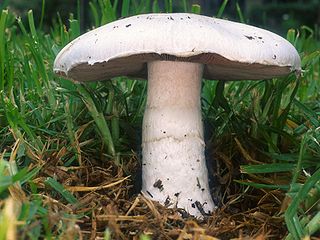
The Agaricales are an order of fungi in the division Basidiomycota. As originally conceived, the order contained all the agarics, but subsequent research has shown that not all agarics are closely related and some belong in other orders, such as the Russulales and Boletales. Conversely, DNA research has also shown that many non-agarics, including some of the clavarioid fungi and gasteroid fungi belong within the Agaricales. The order has 46 extant families, more than 400 genera, and over 25,000 described species, along with six extinct genera known only from the fossil record. Species in the Agaricales range from the familiar Agaricus bisporus and the deadly Amanita virosa to the coral-like Clavaria zollingeri and bracket-like Fistulina hepatica.

The Strophariaceae are a family of fungi in the order Agaricales. Under an older classification, the family covered 18 genera and 1316 species. The species of Strophariaceae have red-brown to dark brown spore prints, while the spores themselves are smooth and have an apical germ pore. These agarics are also characterized by having a cutis-type pileipellis. Ecologically, all species in this group are saprotrophs, growing on various kinds of decaying organic matter. The family was circumscribed in 1946 by mycologists Rolf Singer and Alexander H. Smith.

The Marasmiaceae are a family of fungi in the order Agaricales. Basidiocarps are most frequently agarics, but occasionally cyphelloid. According to a 2008 estimate, the family contained 54 genera and 1590 species, but molecular research, based on cladistic analysis of DNA sequences, has led to a more restricted family concept, so that the Marasmiaceae included just 13 genera, and some 1205 species. It was reduced further down in 2020, to 10 genera and about 700 species.
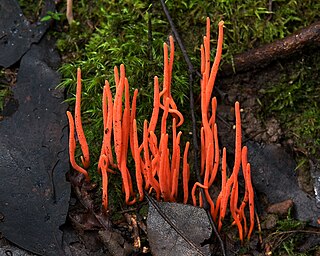
The Clavariaceae are a family of fungi in the order Agaricales. Originally the family contained most of the clavarioid fungi, but in its current sense is more restricted, albeit with a greater diversity of basidiocarp forms. Basidiocarps are variously clavarioid or agaricoid (mushroom-shaped), less commonly corticioid or hydnoid.

The Tricholomataceae are a large family of fungi within the order Agaricales. Originally a classic "wastebasket taxon", the family included any white-, yellow-, or pink-spored genera in the Agaricales not already classified as belonging to e.g. the Amanitaceae, Lepiotaceae, Hygrophoraceae, Pluteaceae, or Entolomataceae.

The Hymenogastraceae is a family of fungi in the order Agaricales with both agaric and false-truffle shaped fruitbodies. Formerly, prior to molecular analyses, the family was restricted to the false-truffle genera. The mushroom genus Psilocybe in the Hymenogastraceae is now restricted to the hallucinogenic species while nonhallucinogenic former species are largely in the genus Deconica classified in the Strophariaceae.
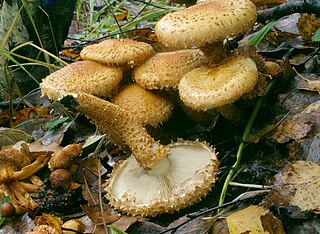
Pholiota is a genus of small to medium-sized, fleshy mushrooms in the family Strophariaceae. They are saprobes that typically live on wood. The genus has a widespread distribution, especially in temperate regions, and contains about 150 species.

The Inocybaceae are a family of fungi in the order Agaricales, the largest order of mushroom-forming fungi. It is one of the larger families within Agaricales. This family exhibits an ectomycorrhizal ecology. Members of this family have a widespread distribution in tropical and temperate areas.
The Doassansiales are an order of fungi in the class Exobasidiomycetes. The order consist of three families: the Doassansiaceae, the Melaniellaceae, and the Rhamphosporaceae.

The Entylomatales are an order of smut fungi in the class Exobasidiomycetes. A monotypic order, it consists of a single family, the Entylomataceae. Both the family and order were circumscribed in 1997.

The Exobasidiales are an order of fungi in the class Exobasidiomycetes. The order consists of four families as well as one genus, Cladosterigma, not assigned to any family.

The Georgefischeriales are an order of smut fungi in the class Exobasidiomycetes. The order consists of four families, the Eballistraceae, the Georgefischeriaceae, the Gjaerumiaceae, and the Tilletiariaceae.

The Microstromatales are order of fungi in the class Exobasidiomycetes. The order consists of three families: the Microstromataceae, the Quambalariaceae, and the Volvocisporiaceae.
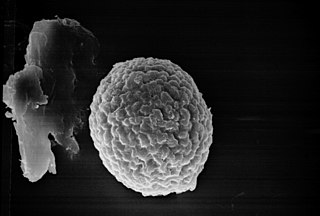
The Tilletiales are an order of smut fungi in the class Exobasidiomycetes. It is a monotypic order, consisting of a single family, the Tilletiaceae, which contains seven genera. The roughly 150 species in the Tilletiales all infect hosts of the grass family, except for species of Erratomyces, which occur on legumes.

Phaeomarasmius is a genus of fungi in the family Tubariaceae. It was formerly thought to belong in the family Inocybaceae. The genus has a widespread distribution, and contains about 20 species.
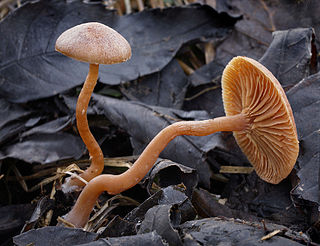
Tubaria is a genus of fungi in the family Tubariaceae. The genus is widely distributed, especially in temperate regions. Tubaria was originally named as a subgenus of Agaricus by Worthington George Smith in 1870. Claude Casimir Gillet promoted it to generic status in 1876. The mushrooms produced by species in this genus are small- to medium-sized with caps ranging in color from pale pinkish-brown to reddish-brown, and often with remnants of the partial veil adhering to the margin. Mushrooms fruit on rotting wood, or, less frequently, in the soil. There are no species in the genus that are recommended for consumption.

Mycopan is one of several genera of agaric fungi (mushrooms) that were formerly classified in the genus Hydropus or Mycena. Mycopan is currently monotypic, containing the single species Mycopan scabripes. It produces dusky colored fruit bodies that are mycenoid, but lack amyloid or dextrinoid tissues except for the amyloid basidiospores. Its stipe is notably scruffy from cystidioid end cells and unlike true Hydropus it does not bleed clear fluid. Phylogenetically, Mycopan is distant from the Mycenaceae and the type of that family, Mycena, and it is not with the type of Hydropus, Hydropus fuliginarius. Mycopan grouped closest to Baeospora. Baeospora was shown to be in the Cyphellaceae by Matheny and colleagues. Mycopan scabripes grows from debris in forest floors in North America and Europe.

The Porotheleaceae are a family of saprotrophic, mainly wood-decay fungi in the order Agaricales that are primarily agarics, but also include cyphelloid fungi. The family had been informally cited in the literature as the 'hydropoid' clade. The type genus, Porotheleum, was placed in the phylogenetically defined clade in 2002 but the clade was more strongly supported in 2006 though without including Porotheleum. Its sister group is the Cyphellaceae, both in the 'marasmioid clade'. Some included taxa are cultivated by ants. More recently the family was recognized in three analyses that included Porotheleum.

Flammula is a dark brown-spored genus of mushrooms that cause a decay of trees, on whose bases they often fruit, forming clusters of yellowish brown mushrooms.

The Tubariaceae is a family of basidiomycete fungi described by Alfredo Vizzini in 2008.



















